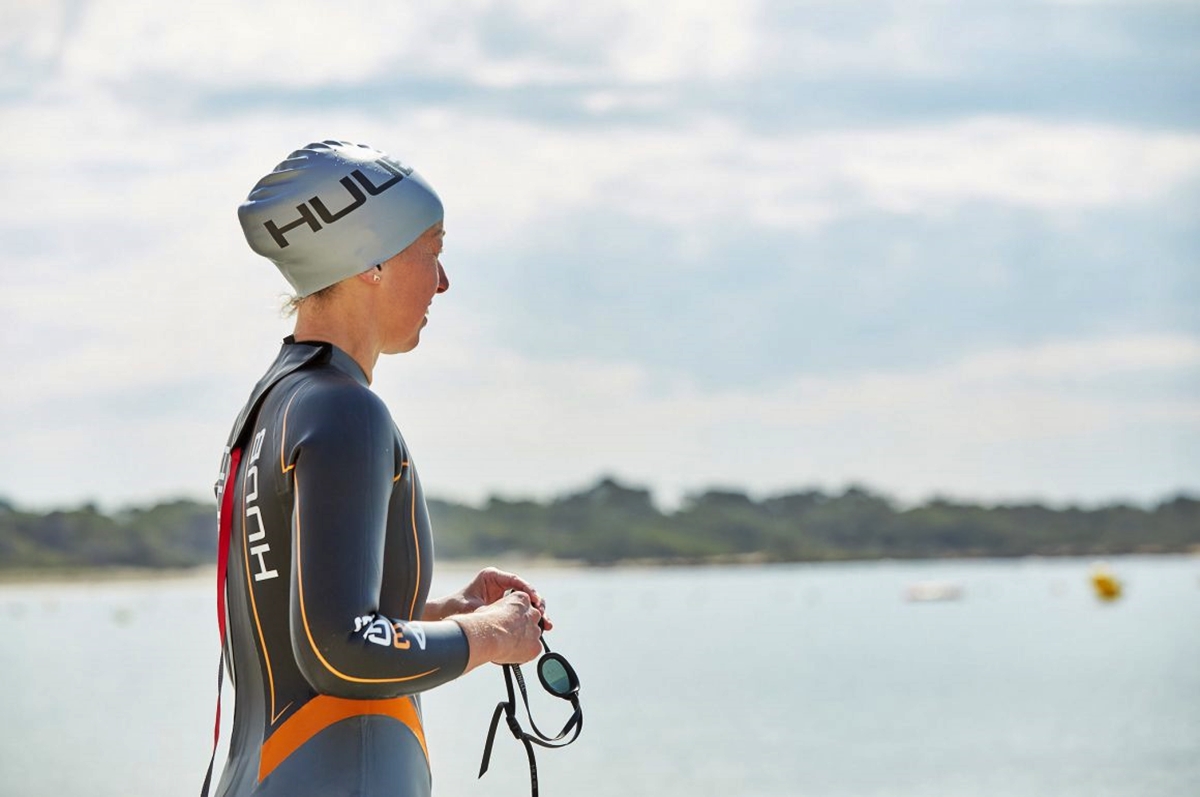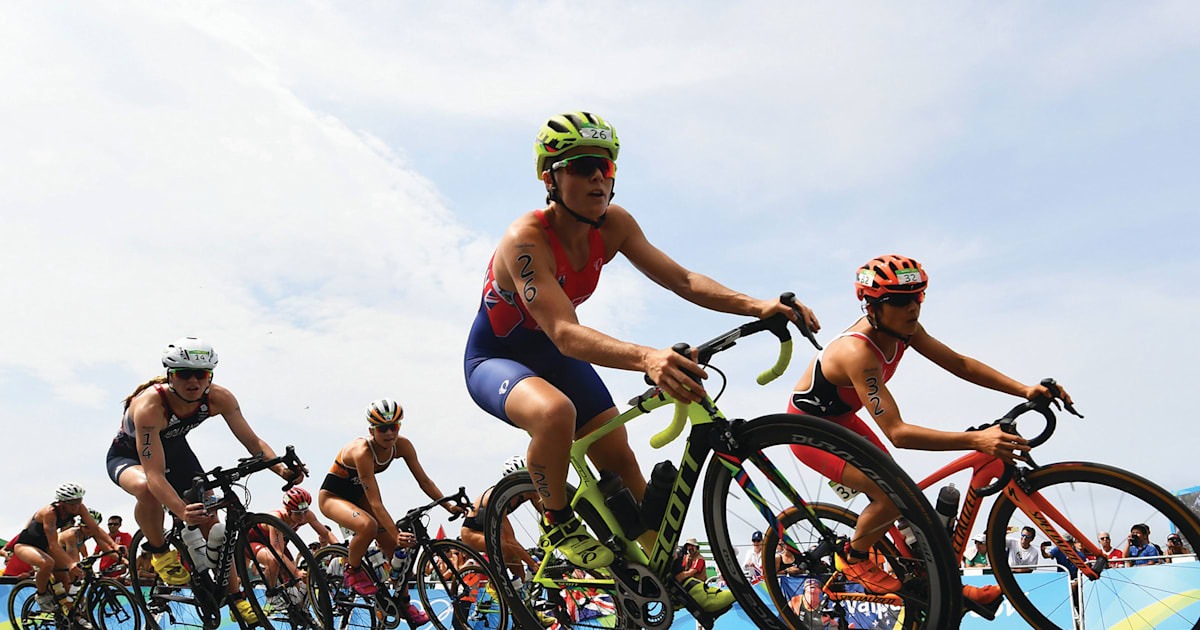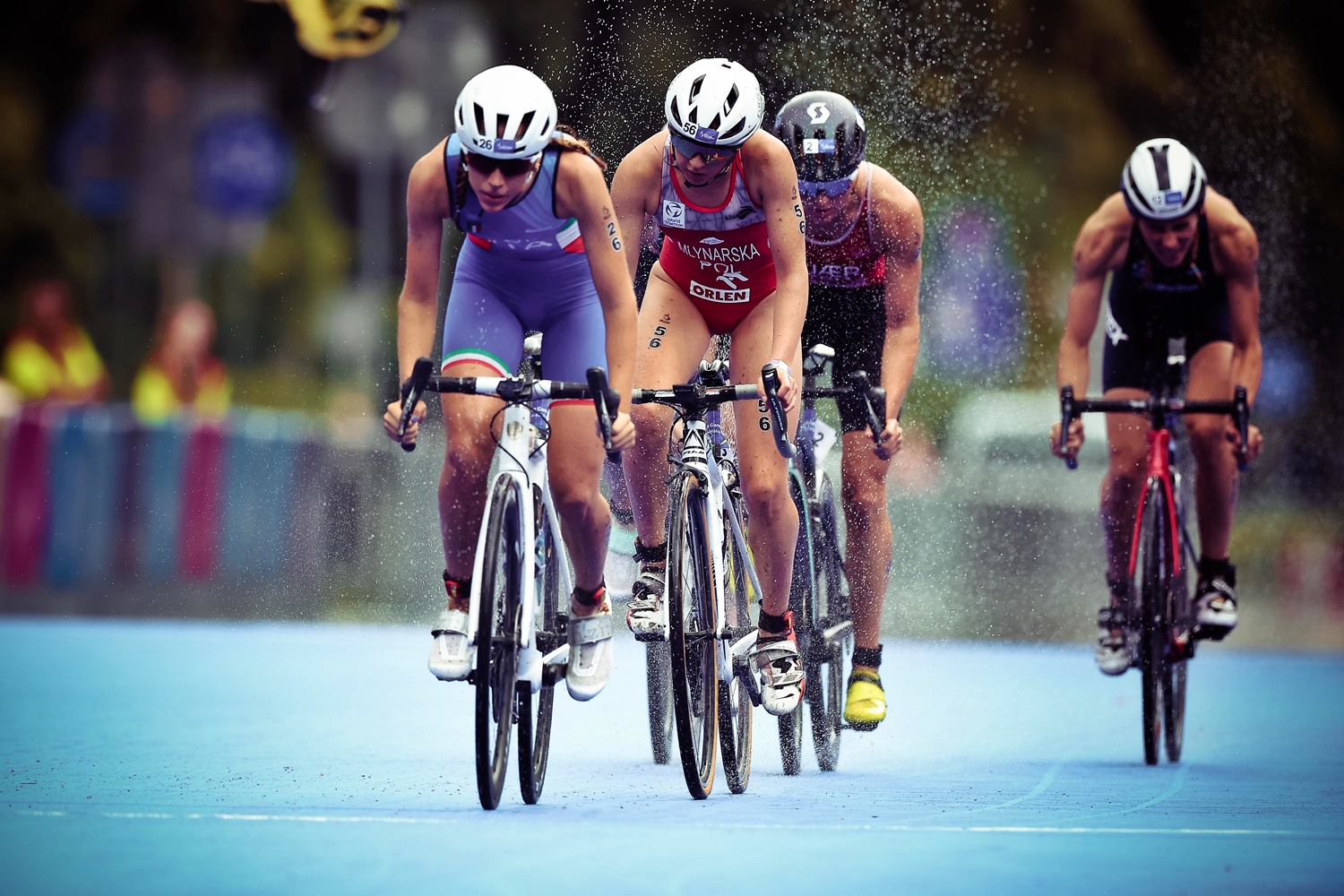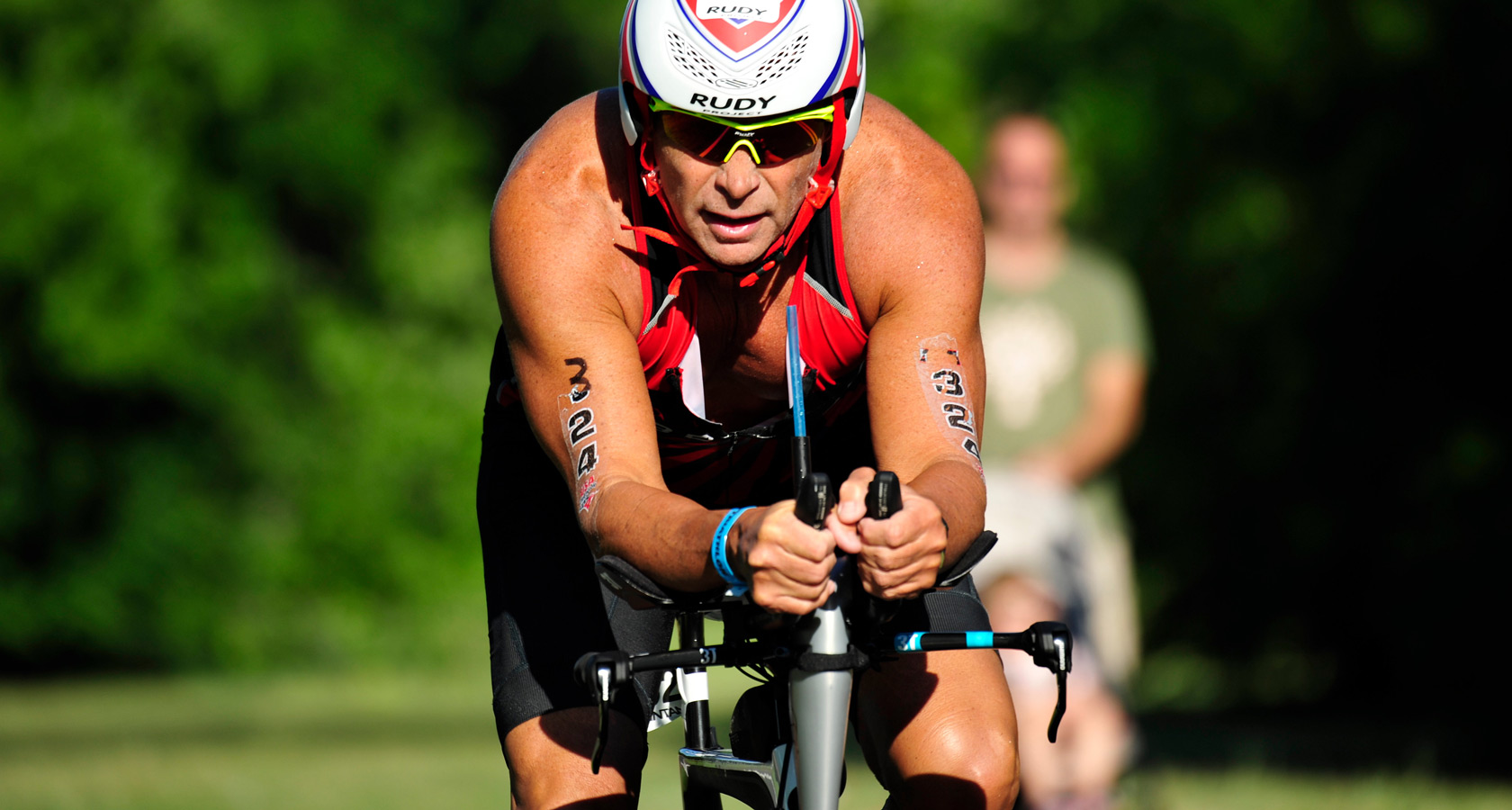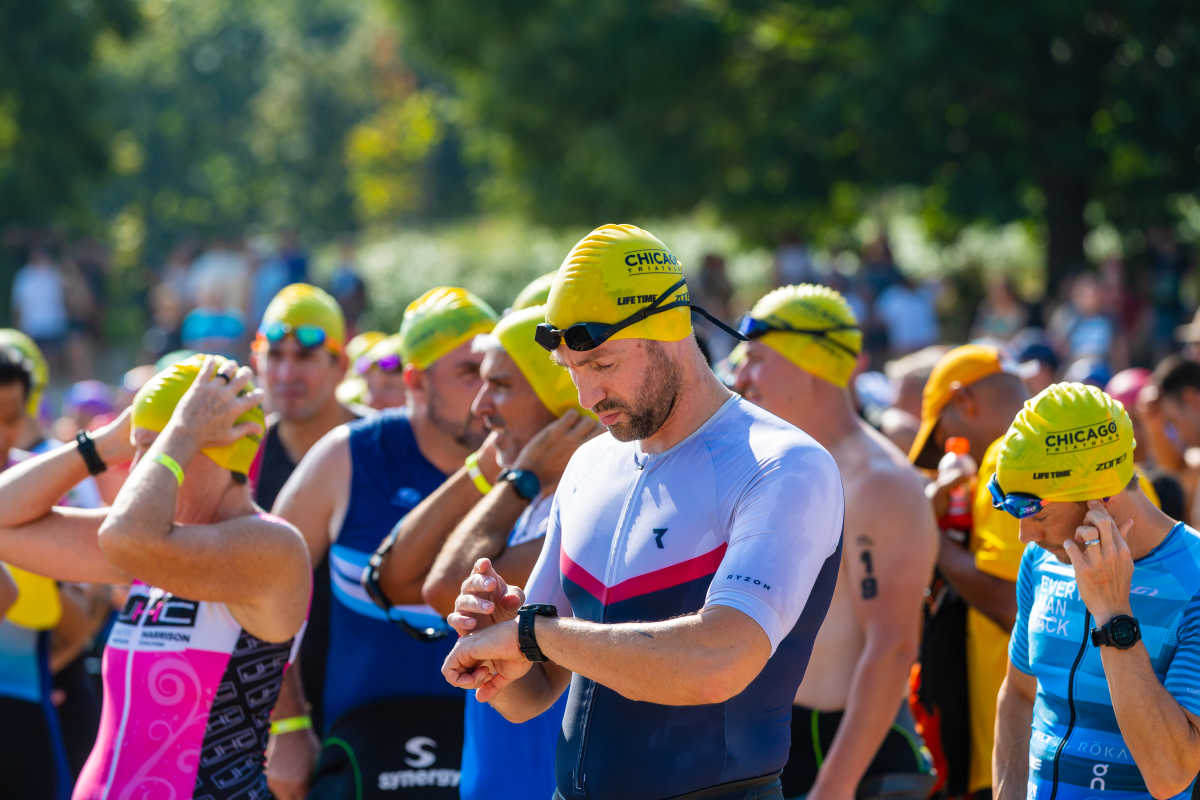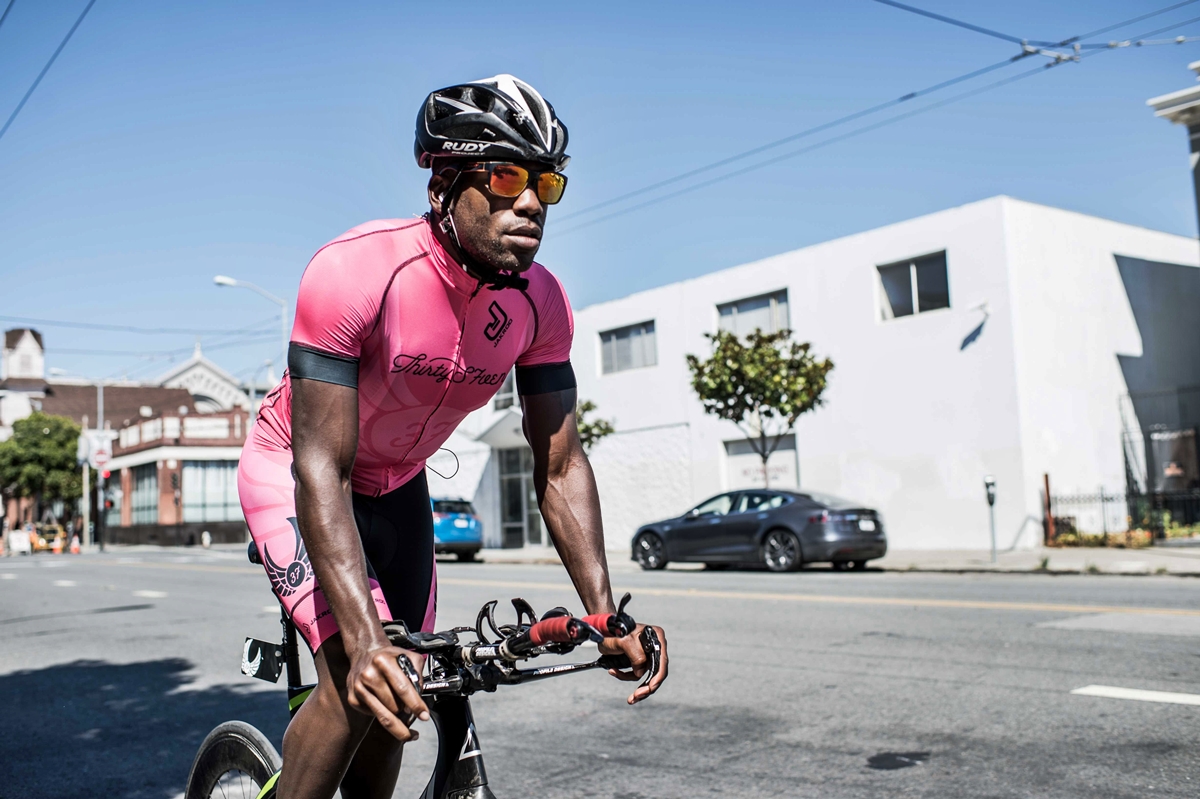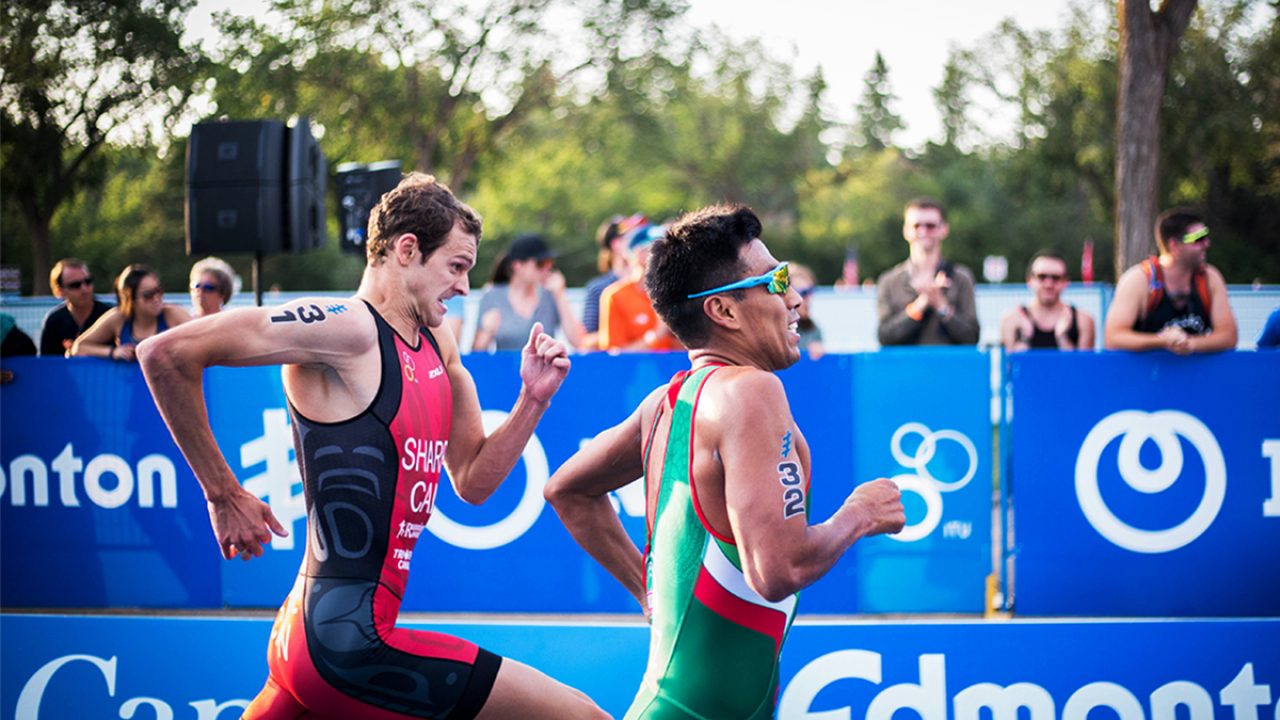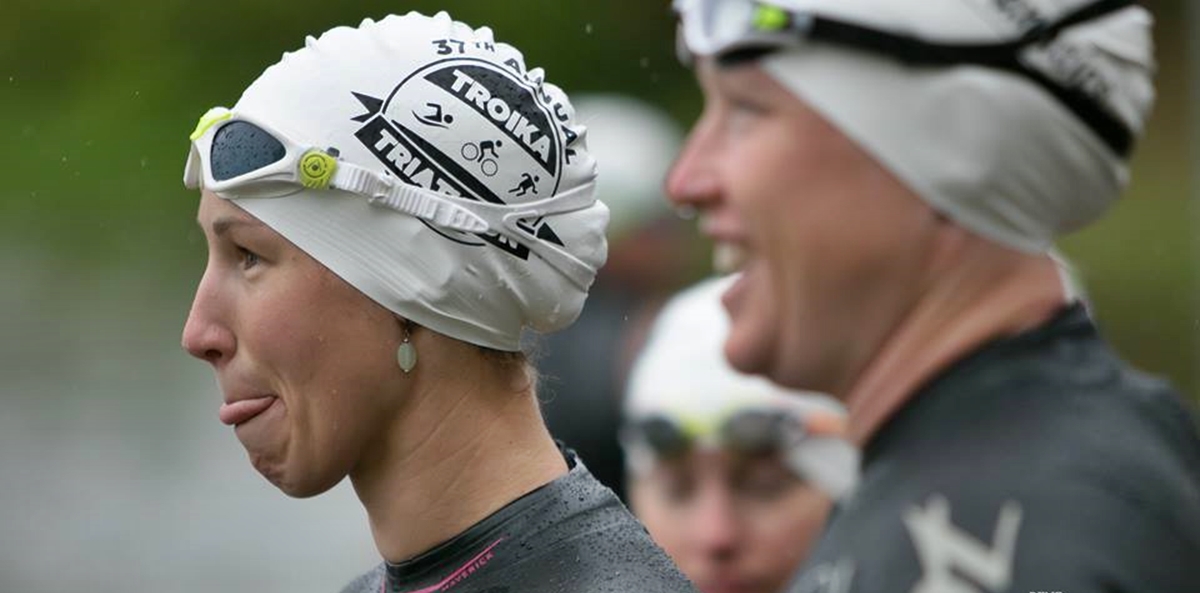Home>Misc>Featured>How To Train For A Triathlon For Beginners


Featured
How To Train For A Triathlon For Beginners
Modified: August 21, 2023
Get expert tips on how to train for a triathlon as a beginner. Discover the featured exercises and techniques to conquer your first triathlon!
Introduction
Welcome to the exciting world of triathlon! Whether you’re a fitness enthusiast looking for a new challenge or a beginner seeking to embrace a healthier lifestyle, training for a triathlon can be a transformative experience. Triathlon consists of three disciplines: swimming, cycling, and running, making it a diverse and demanding sport that pushes your physical and mental limits.
In this comprehensive guide, we will take you through the essential steps of training for a triathlon as a beginner. From setting your goals to crossing the finish line, we’ll provide valuable insights and tips to help you navigate the training process and achieve success.
The key to preparing for a triathlon lies in finding the right balance between the three disciplines. Each discipline requires specific training techniques, as well as physical and mental stamina. It’s essential to approach your training with a comprehensive plan that includes swimming, cycling, and running workouts, along with strength and cross-training exercises.
Beyond the physical aspect, triathlon training also involves mental preparation and strategic race day planning. Developing a positive mindset, managing nerves, and understanding the logistics of transitions are all crucial elements to consider.
While training for a triathlon may seem daunting at first, remember that every journey starts with a single step. With dedication, discipline, and the right guidance, you can gradually build your endurance and accomplish remarkable feats.
Throughout this guide, we’ll delve into the different aspects of triathlon training, offering valuable insights and practical advice to help you overcome challenges and maximize your potential. So let’s dive in and embark on this incredible journey together!
Setting Your Goals
Before you begin your triathlon training journey, it’s crucial to set clear and attainable goals. Goal-setting provides focus and motivation, guiding you throughout the training process. Whether you want to complete a sprint triathlon, improve your time, or simply finish the race, defining your goals will help shape your training plan.
Start by asking yourself why you want to participate in a triathlon. Is it for personal achievement, to challenge yourself, or to embrace a healthier lifestyle? Understanding your motivations will help you set meaningful goals that resonate with you.
Your goals should be specific, measurable, attainable, relevant, and time-bound (SMART goals). For example, a specific goal could be completing a sprint triathlon within six months. Measurable goals can focus on improving your swimming or running times by a certain percentage. Ensure that your goals are realistic and aligned with your current fitness level and available training time. It’s better to set challenging yet achievable goals that will push you without overwhelming you.
In addition to setting your overall triathlon goal, consider setting smaller milestone goals along the way. These milestones can include completing a certain distance in the pool, achieving a specific cycling speed, or running a particular distance without stopping.
Writing down your goals and placing them somewhere visible will serve as a constant reminder and keep you motivated when the training gets tough. It’s also important to regularly revisit and assess your goals to track your progress and make any necessary adjustments.
Remember, your goals should be personal to you and not based on what others are doing. Stay true to your own aspirations and celebrate every milestone you achieve along the way.
Selecting the Right Race
Choosing the right triathlon race is an important step in your training journey. Consider factors such as distance, location, and race atmosphere to find a race that aligns with your goals and preferences.
First, determine the distance that suits your current fitness level and goals. Triathlons come in various distances, ranging from sprint (typically 0.5-mile swim, 12.4-mile bike, and 3.1-mile run) to Olympic, Half-Ironman, and even Ironman distances. If you’re a beginner, it’s generally advisable to start with a shorter distance to acclimate yourself to the demands of the sport and gradually build your endurance.
Location is another important consideration. Look for races that are convenient for you to travel to or are close to your home. Consider factors such as weather, terrain, and accessibility, as they can play a significant role in your race experience.
Additionally, take into account the race atmosphere. Some races are highly competitive, while others are more focused on fun and participation. Choose a race that fits your personality and the type of experience you’re seeking.
Research different races by visiting event websites, reading race reviews, and talking to fellow triathletes. Pay attention to any special features or challenges that a race may offer, such as open-water swims, hilly bike courses, or scenic run routes.
Lastly, don’t forget to consider the race date and give yourself enough time to prepare. Make sure you have sufficient time to train adequately for your chosen distance and take into account any other commitments or events that may affect your training schedule.
When selecting a race, keep in mind that your first triathlon is a learning experience. It’s okay to start with a smaller, local race to familiarize yourself with the logistics and flow of a triathlon. As you gain confidence and experience, you can gradually tackle more challenging races.
Ultimately, choosing the right race is about finding a balance between challenge and enjoyment. Set yourself up for success and choose a race that excites and motivates you. Remember, every race is an opportunity to grow, learn, and celebrate your accomplishments.
Creating a Training Schedule
When it comes to triathlon training, consistency is key. Creating a well-structured training schedule will help you stay organized, track your progress, and ensure that you’re giving each discipline the attention it deserves.
Begin by assessing your current fitness level and determining how many hours per week you can commit to training. Remember to consider your other obligations and make sure to strike a balance between training, work, family, and rest.
Divide your training schedule into blocks, with each block focusing on a specific discipline. This will help you prioritize and allocate adequate time and energy to swimming, cycling, and running. Aim for a balanced distribution, giving equal attention to all three disciplines.
Within each discipline, vary your workouts to include a mix of endurance, speed, and technique sessions. Endurance sessions will help build your stamina, while speed sessions will improve your pace. Technique sessions will focus on refining your swimming stroke, cycling form, and running technique.
It’s important to incorporate rest days into your training schedule to allow your body to recover and prevent overtraining. These rest days are just as important as training days and will help prevent injuries and burnout. Consider scheduling at least one complete rest day per week, along with lighter recovery sessions.
As you progress in your training, gradually increase the duration and intensity of your workouts. This progressive overload will help build your endurance and prepare your body for the demands of race day. However, be mindful not to increase volume or intensity too rapidly, as this can lead to injury or fatigue. Gradual and sustainable progression is key.
Consider seeking guidance from a coach or following a structured training plan. Coaches can provide personalized feedback, monitor your progress, and help you navigate any challenges along the way. Training plans, whether from experienced coaches or reputable sources, offer a pre-designed schedule that caters to different fitness levels and race distances.
Lastly, be flexible with your training schedule. Life happens, and there may be instances where you need to make adjustments. Allow for some flexibility to accommodate unforeseen events, illness, or unforeseen circumstances. Remember, it’s about consistency over time rather than perfection in every single workout.
By creating a well-rounded and tailored training schedule, you’ll be able to maximize your training time, improve your performance, and ultimately achieve your triathlon goals.
Swimming Techniques and Workouts
Swimming is often considered the most challenging discipline for beginners in triathlon. But with proper technique and dedicated practice, you can develop the swimming skills necessary to confidently tackle the water portion of the race. Here are some techniques and workouts to help you improve your swimming:
1. Focus on Technique: Technique is crucial in swimming. Start by mastering your breathing pattern, body position, and stroke mechanics. Focus on maintaining a streamlined position, keeping your body horizontal in the water, and practicing a relaxed and efficient stroke.
2. Drills: Incorporate swimming drills into your training to further refine your technique. Examples include kicking on your back, using a kickboard, or performing single arm drills to isolate and improve specific aspects of your stroke.
3. Interval Training: Interval training involves swimming a set distance or time at a high intensity, followed by a short rest period. This type of training helps improve your speed, endurance, and cardiovascular fitness. Start with shorter intervals and gradually increase the distance and intensity as you progress.
4. Bilateral Breathing: Practice breathing on both sides to develop bilateral breathing technique. This will help you swim more efficiently and maintain balance, especially in open water swim conditions.
5. Open Water Practice: If your triathlon includes an open water swim, it’s essential to practice in similar conditions. Find a local lake, ocean, or swimming pool with open water practice sessions to simulate the race environment. This will help build your confidence and adapt to sighting techniques.
6. Endurance Sets: Incorporate longer swim sets into your training to build endurance. Gradually increase the distance, aiming to swim continuously without stopping. This will simulate the demands of the race and improve your overall swimming efficiency.
7. Join a Masters Swim Group: Consider joining a Masters swim group or swimming club. Swimming with other experienced swimmers will push you to improve and provide valuable feedback to further enhance your technique.
8. Take Video Analysis: Record yourself swimming and seek expert advice or analyze your technique. Video analysis can help identify areas for improvement and allow you to visualize your stroke and body position in the water.
Remember, consistency and practice are key to improving your swimming abilities. Stay committed to your swimming workouts and gradually build up your distance and speed. With time, patience, and dedication, you will gain the confidence and skills needed to conquer the swim portion of your triathlon.
Cycling Tips and Training Plans
Cycling is a crucial component of triathlon and requires both physical strength and technical skill. Whether you’re a beginner or an experienced cyclist, here are some tips and training plans to help you improve your cycling performance:
1. Bike Fit: Ensure that your bike is properly fitted to your body. A professional bike fitting can help optimize your position, prevent injuries, and improve your cycling efficiency.
2. Building Endurance: Start by gradually increasing your cycling distance and duration. Focus on building your endurance base before incorporating more intense workouts. Long, steady rides at a moderate pace will help prepare your body for the demands of race day.
3. Interval Training: Incorporate interval training into your cycling workouts. Alternate between periods of high intensity, such as sprinting or climbing, and recovery periods. Interval training improves your cardiovascular fitness, speed, and power.
4. Hill Training: Include hill repeats in your training to improve your climbing ability. Find a challenging hill and repeatedly ride up and down, focusing on maintaining proper form and pacing yourself.
5. Cadence: Practice maintaining a consistent cadence (pedaling speed) during your rides. Aim for a cadence of around 80-100 revolutions per minute. This will help improve your pedaling efficiency and reduce muscle fatigue.
6. Brick Training: Incorporate brick workouts into your training, which involve combining cycling immediately followed by a run. This will help your body adapt to the transition between the bike and run disciplines, improving your overall race performance.
7. Group Rides: Join local cycling groups or participate in organized group rides. Riding with others can provide motivation, help you learn from more experienced cyclists, and simulate race scenarios.
8. Nutrition and Hydration: Practice proper nutrition and hydration during your longer rides. Learn how to fuel your body with the right balance of carbohydrates, proteins, and electrolytes to sustain your energy levels and prevent dehydration.
9. Bike Handling Skills: Work on your bike handling skills, such as cornering, braking, and gear shifting. Practice these skills in a safe environment to improve your confidence and safety on the road.
10. Recovery: Allow for adequate recovery between your cycling workouts. This will help prevent overtraining and promote muscle repair and growth. Incorporate rest days and lighter recovery rides into your training schedule.
Remember to always prioritize safety while cycling. Wear appropriate safety gear, follow traffic rules, and be aware of your surroundings. With consistent training, proper technique, and a focused mindset, you’ll be well on your way to improving your cycling performance and conquering the bike leg of your triathlon.
Running Techniques and Training Programs
Running is the final discipline in a triathlon, and it’s crucial to develop proper running technique and endurance to finish strong. Whether you’re a beginner or an experienced runner, here are some techniques and training programs to help you improve your running performance:
1. Proper Running Form: Focus on maintaining good running form to improve efficiency and reduce the risk of injury. Keep your posture tall, relax your shoulders, and engage your core. Land with a midfoot or forefoot strike and maintain a quick cadence.
2. Gradual Progression: Begin your running training with shorter distances and gradually increase your mileage as your endurance improves. This gradual progression helps prevent overuse injuries and allows your body to adapt to the demands of running.
3. Interval Training: Incorporate interval training into your running workouts. Alternate between periods of high intensity, such as sprints or faster-paced intervals, and recovery periods. Interval training helps improve your speed, endurance, and lactate threshold.
4. Long Runs: Include a weekly long run to build your endurance. Start with a comfortable distance and gradually increase the length of your long run over time. These longer runs help simulate the demands of the run leg in a triathlon.
5. Tempo Runs: Tempo runs are moderately paced runs at a challenging, but sustainable, effort level. This type of workout helps improve your lactate threshold and teaches your body to maintain a faster, more efficient pace over extended distances.
6. Hill Repeats: Incorporate hill repeats into your training to build leg strength and improve your aerobic capacity. Find a moderately steep hill and run hard uphill, focusing on maintaining good form. Recover on the way down and repeat the process.
7. Brick Training: Practice running directly off the bike to get your body accustomed to the feeling of running after cycling. Incorporate short runs immediately after your bike workouts to adapt to the transition and train your legs to adjust to the different demands.
8. Cross-Training: Include cross-training activities, such as swimming or cycling, to supplement your running. These activities help prevent overuse injuries, strengthen different muscle groups, and provide a break from the impact of running.
9. Rest and Recovery: Allow for rest days in your training schedule to give your body time to recover and repair. Rest and recovery are crucial for reducing the risk of injuries and allowing your muscles to adapt and grow stronger.
10. Consistency: Consistency is key in running. Aim to run regularly, following your training plan, to build your fitness and improve your running performance. Even short, consistent runs can make a significant difference in your overall progress.
Remember to listen to your body and adjust your training intensity or distance if needed. Take care of any minor aches or pains early on to prevent them from becoming more significant injuries. With consistent training, a focus on proper technique, and a gradual progression, you’ll improve your running performance and cross the finish line with confidence.
Transitioning between Disciplines
Transitions are a critical aspect of triathlon and can greatly affect your overall race performance. Transitioning efficiently and smoothly between the swim, bike, and run disciplines can save you valuable time and energy. Here are some tips to help you navigate the transitions successfully:
1. Practice Makes Perfect: Dedicate specific training sessions to practice your transitions. Set up a transition area and practice going from swimming to cycling and from cycling to running. Familiarize yourself with the layout, organize your gear, and practice the sequences repeatedly to build muscle memory.
2. Set Up Your Transition Area: Lay out your gear in a systematic and organized manner. Place your bike in the designated area and arrange your running shoes, cycling shoes, helmet, sunglasses, and any other necessary items within easy reach. Have a towel handy to dry off and wipe your feet if needed.
3. Use a Checklist: Create a checklist of all the items you need for each discipline and review it before entering the transition area. This ensures that you don’t forget any essential gear and helps streamline your transition process.
4. Practice Quick Transitions: Work on reducing your transition times by practicing quick and efficient movements. Practice taking off your wetsuit or swim cap swiftly, putting on your shoes, and getting on and off your bike quickly and smoothly. Efficiency is key.
5. Use Elastic Laces: Invest in elastic laces for your running shoes. These laces allow you to slip your shoes on quickly without tying them, saving you valuable seconds. Practice using them in training to get comfortable with the process.
6. Visualize the Transitions: Mentally rehearse the transitions in your mind before the race. Visualize each step and practice the movements mentally. This mental preparation helps to reduce anxiety and increase confidence.
7. Know the Layout: Familiarize yourself with the transition area and the racecourse layout. Know where the entry and exit points are for each discipline. This knowledge will help you navigate the transitions smoothly and minimize the chances of getting disoriented.
8. Stay Calm and Focused: During the transitions, stay calm, composed, and focused on the task at hand. Avoid rushing or panicking, as this can lead to mistakes or forgetting essential items. Take a deep breath, maintain a steady pace, and stay in control of your movements.
9. Practice Transitions with Brick Workouts: Incorporate brick workouts into your training regimen. This involves going directly from one discipline to another, such as running immediately after cycling. Brick workouts simulate race conditions and help your body adapt to the transitions.
10. Learn from Others: Observe experienced triathletes during races or training sessions to learn transition techniques and strategies. Take note of their efficient movements and organizational skills. Speak with fellow triathletes or coaches to gain insights and tips on improving your transitions.
Remember, transitions can be a valuable opportunity to gain an advantage over your competitors. By practicing and honing your transition skills, you can make the most of these critical moments and ensure a smooth and efficient experience during your triathlon journey.
Strength and Cross Training
Strength and cross training are essential components of triathlon training that can enhance your performance, prevent injuries, and promote overall fitness. Incorporating these elements into your training plan will help you develop a well-rounded and strong body capable of meeting the demands of all three triathlon disciplines. Here are some key benefits and tips for incorporating strength and cross training:
Enhanced Performance: Regular strength training can improve your power, speed, and endurance across all disciplines. Building strength in your legs, core, and upper body will improve your cycling and running performance, while also enhancing your swimming technique.
Injury Prevention: Strength training helps strengthen muscles, tendons, and ligaments, reducing the risk of overuse injuries. Additionally, developing core strength can improve your stability and posture, enhancing your overall form and reducing the risk of common triathlon-related injuries.
Balance and Coordination: Cross training activities such as yoga, Pilates, or balance exercises can improve your stability and balance, which are crucial for maintaining proper form and technique during all three disciplines.
Recovery and Active Rest: Cross training activities allow for active recovery and rest days, providing a break from the impact of swimming, cycling, and running. Low-impact activities like swimming, yoga, or cycling can help alleviate muscle soreness and promote recovery.
Time Management: Cross training provides an opportunity to work on different muscle groups while giving the overworked muscles used in swimming, cycling, and running a chance to recover. You can schedule cross training sessions when you’re unable to perform intense training for any of the three disciplines.
Include Resistance Training: Incorporate resistance exercises, such as squats, lunges, deadlifts, and push-ups, into your strength training routine. These exercises target multiple muscle groups and help build functional strength for the demands of triathlon.
Core Strength: Focus on core exercises to improve stability and posture. Planks, Russian twists, and bicycle crunches are great exercises for developing a strong core, which plays a vital role in all three disciplines.
Cross Training Options: Consider activities like swimming, cycling, rowing, yoga, Pilates, or using an elliptical machine. These low-impact exercises help work different muscle groups, improve cardiovascular fitness, and aid in recovery.
Flexibility and Mobility: Incorporate exercises that improve flexibility and mobility, such as dynamic and static stretching, foam rolling, and yoga. Maintaining good flexibility helps prevent injuries and allows for smoother and more efficient movement.
Periodization: Plan your strength and cross training sessions strategically, integrating them into your overall training plan. Adjust the frequency and intensity of these workouts based on your training phase and race goals.
Listen to Your Body: Pay attention to signs of fatigue or overtraining, and adjust your strength and cross training accordingly. Rest days are just as important as training days to allow your body to recover and adapt to the new demands placed upon it.
Remember, strength and cross training are complementary to your swim, bike, and run workouts. By incorporating these activities into your training routine, you can improve your performance, enhance your overall fitness, and reduce the risk of injuries, ultimately helping you reach your triathlon goals.
Rest and Recovery
Rest and recovery are an integral part of triathlon training that often goes overlooked. Proper rest allows your body to repair, adapt, and grow stronger, helping maximize your performance on race day. Here are some reasons why rest and recovery are essential and tips for incorporating them into your training plan:
Preventing Overtraining: Rest days are crucial for preventing overtraining and burnout. Pushing your body without allowing adequate recovery can lead to decreased performance, fatigue, and increased risk of injuries. Build rest days into your training schedule to give your body time to recover and rejuvenate.
Repair and Rebuild: During rest periods, your body repairs damaged tissues and rebuilds muscle fibers that have been broken down during training. This repair process is crucial for muscle growth and strength development.
Reducing Injury Risk: Rest and recovery provide an opportunity for your body to heal and reduce the risk of overuse injuries. Continuous training without proper recovery can lead to chronic fatigue, decreased immune function, and increased susceptibility to injury.
Mental and Emotional Well-being: Rest days are not just about physical recovery but also mental and emotional rejuvenation. Training for a triathlon can be mentally demanding, and rest allows you to recharge, refocus, and maintain a healthy mindset.
Quality Sleep: Adequate sleep is a vital component of rest and recovery. Aim for 7-9 hours of quality sleep each night to optimize your hormone regulation, tissue repair, and overall well-being. Establish a regular sleep routine and create a sleep-friendly environment to ensure you get the rest you need.
Active Recovery: Incorporate low-intensity activities during rest days to aid in recovery. Gentle activities like walking, swimming, or light cycling can promote blood flow, reduce muscle soreness, and maintain mobility without adding stress to your body.
Listen to Your Body: Pay attention to your body’s signals and adjust your training schedule accordingly. If you’re feeling excessively fatigued, sore, or lacking motivation, it may be a sign that you need extra rest. Be flexible and give yourself permission to take additional rest days as needed.
Relaxation Techniques: Incorporate relaxation techniques like deep breathing, meditation, or yoga into your routine. These practices help reduce stress, promote mental clarity, and aid in relaxation, enhancing your overall recovery process.
Nutrition and Hydration: Proper nutrition and hydration play a vital role in rest and recovery. Fuel your body with balanced meals rich in nutrients to support muscle repair and replenish energy stores. Stay hydrated throughout the day, especially during training, to aid in the recovery process.
Periodization and Tapering: Incorporate planned periods of lower intensity and reduced volume into your training schedule. This allows for concentrated rest and recovery, helping you reach peak performance on race day. Tapering involves gradually decreasing training load in the weeks leading up to a race to optimize performance and minimize fatigue.
Remember, rest and recovery are not signs of weakness but integral parts of the training process. Embrace rest as an essential component of your triathlon journey and give your body the time and care it needs to thrive. By prioritizing rest and recovery, you’ll enhance your performance, reduce the risk of injuries, and ensure you’re ready to conquer the challenges that lie ahead.
Nutrition and Hydration
Nutrition and hydration play a crucial role in triathlon training and racing. Proper fueling and hydration can enhance your performance, promote recovery, and help you sustain energy levels throughout each discipline. Here are some important tips and considerations to optimize your nutrition and hydration strategy:
Balance and Variety: Aim for a well-balanced diet that includes a variety of whole foods, including lean proteins, complex carbohydrates, healthy fats, and a range of fruits and vegetables. This ensures you’re getting the necessary nutrients for optimal performance and recovery.
Timing: Pay attention to the timing of your meals and snacks, especially before training sessions and races. Fuel up with a balanced meal or snack 1-3 hours before training to provide the energy your body needs. Experiment with different timing strategies to find what works best for you.
Pre-Workout Fuel: Consume a small, easily digestible meal or snack before training to provide immediate energy. Opt for foods that are rich in carbohydrates and moderate in protein and low in fat to avoid any digestive discomfort during exercise.
During Exercise: Depending on the duration and intensity of your training or race, consider incorporating sports drinks, energy gels, or other easily digestible sources of carbohydrates to maintain energy levels. Practice your nutrition strategy during training sessions to assess what works best for you and avoid any digestive issues on race day.
Hydration: Hydration is critical for triathlon performance. Start every training session well-hydrated and continue to drink fluids throughout your workout. Aim to consume water and electrolyte-rich beverages to replace the fluids lost through sweat.
Post-Workout Recovery: Refueling after exercise is essential for optimal recovery. Within 30 minutes of completing your training session, consume a snack or meal that includes a mix of carbohydrates and protein to replenish glycogen stores and aid in muscle repair.
Electrolyte Balance: During training or racing, pay attention to maintaining an optimal electrolyte balance. Electrolytes, such as sodium, potassium, and magnesium, play a vital role in fluid balance and muscle function. Consider incorporating electrolyte supplements or sports drinks to replenish these minerals during longer sessions.
Individualized Approach: Experiment with different foods, fluids, and timing strategies during training to find what works best for your body. Every athlete is unique, and it’s important to tailor your nutrition and hydration plan according to your preferences, tolerances, and goals.
Professional Guidance: Consider seeking guidance from a sports nutritionist or dietitian who specializes in endurance sports. They can provide personalized advice and help you create a nutrition and hydration plan that meets your specific needs and goals.
Consistency: Consistency is key when it comes to nutrition and hydration. Establish healthy eating habits and hydration practices in your daily life, not just during training or racing. This will support your overall health and performance as an endurance athlete.
Remember, nutrition and hydration should be an integral part of your triathlon training. Focusing on a balanced diet, proper hydration, and individualized strategies will help you perform at your best and optimize your overall triathlon experience.
Mental Preparation
Mental preparation is a crucial aspect of triathlon training and racing. Developing a strong and resilient mindset can help you overcome challenges, stay motivated, and perform at your best. Here are some key strategies to enhance your mental preparation for triathlon:
Goal Setting: Set specific and attainable goals for your triathlon journey. Having clear goals provides focus and motivation, giving you a sense of purpose throughout your training and on race day.
Visualization: Use visualization techniques to mentally rehearse your race. Visualize yourself swimming, cycling, and running, imagining every detail of the course and picturing yourself crossing the finish line with confidence and strength.
Positive Self-Talk: Monitor your inner dialogue and replace negative thoughts with positive affirmations. Use encouraging and motivating words to boost your confidence and overcome self-doubt during training and racing.
Embrace Challenges: Triathlon is a demanding sport that presents numerous challenges. Embrace these challenges as opportunities for growth and learning. Shift your perspective and view obstacles as stepping stones rather than roadblocks.
Focus on Process: Instead of solely fixating on the end result, focus on the process and small victories along the way. Celebrate each training milestone, regardless of how insignificant it may seem. This mindset helps build confidence and momentum leading up to race day.
Manage Nerves: It’s normal to feel nervous before a race. Develop strategies to manage pre-race nerves, such as deep breathing exercises, visualization, or calming routines. Remind yourself that nerves are a sign of excitement and that you have prepared extensively for this moment.
Stay Present: During training and racing, stay present in the moment. Avoid dwelling on the past or worrying about the future. Focus on executing each discipline to the best of your ability and embrace the joy of the journey.
Build Mental Resilience: Triathlon can be physically and mentally challenging. Embrace the discomfort, push through adversity, and develop mental resilience. Practice mental toughness during your training, and it will carry over to race day.
Positive Support Network: Surround yourself with a positive support network of family, friends, and fellow athletes. Seek encouragement, advice, and inspiration from like-minded individuals who uplift and motivate you on your triathlon journey.
Post-Race Reflection: Reflect on each race experience, regardless of the outcome. Celebrate your achievements and identify areas for improvement. This reflection helps inform your training for future races and fuels your motivation to continue progressing.
Stay Flexible: Triathlon requires adaptability. Be prepared for unexpected scenarios or changes on race day. Practice mental flexibility by visualizing different scenarios and preparing backup plans to maintain composure in unforeseen circumstances.
Mental preparation is just as important as physical training for triathlon. By implementing these strategies, you can cultivate a resilient mindset, boost your confidence, and enhance your overall performance in training and on race day.
Preparation on Race Day
Race day is the culmination of your triathlon journey, and proper preparation can make a significant difference in your overall experience. Here are some essential tips to ensure a smooth and successful race day:
Pre-Race Logistics: Familiarize yourself with the race logistics, including the start time, location, and parking arrangements. Plan your travel route and arrive early to allow plenty of time for check-in, setting up your transition area, and warm-up.
Organize Your Gear: Lay out all the gear you’ll need the night before the race. Check that you have everything, including your swim cap, goggles, helmet, running shoes, and any required race numbers or timing chips. Keep it organized to minimize stress on race morning.
Warm-Up Routine: Develop a pre-race warm-up routine and practice it during your training sessions. This routine should include light aerobic exercise, dynamic stretches, and a few short bursts of intensity to prepare your body for the race ahead.
Transition Area: Arrive early to set up your transition area. Familiarize yourself with the layout and ensure your bike is properly racked and your gear is set up neatly. Check your tire pressure, secure your helmet, and have everything organized for quick and easy access during transitions.
Swim Start: Position yourself at the appropriate point in the swim lineup based on your expected swim speed. Take a few moments before the start to calm your mind, focus on your breathing, and mentally prepare for the swim leg. Enter the water confidently and find your rhythm.
Race Pacing: Pace yourself throughout each discipline, especially during the swim and bike legs. Stick to your race plan and avoid getting caught up in the excitement of the early stages. Consistent pacing will help you maintain energy and finish strong.
Nutrition and Hydration: Follow your nutrition and hydration plan that you’ve practiced during training. Consume small amounts of easily digestible carbohydrates and electrolytes during the race to maintain energy levels. Avoid trying new foods or drinks on race day to prevent any digestive issues.
Mental Focus: Use mental strategies such as positive self-talk, visualization, and staying present to maintain focus and motivation throughout the race. Embrace any challenges or setbacks with a positive mindset, knowing that you have prepared diligently for this moment.
Transition Efficiency: Minimize your transition times by staying calm and focused during transitions. Quickly change gear, smoothly transition between disciplines, and keep in mind the checklist you have created. Practice your transitions during training to ensure a seamless process on race day.
Enjoy the Experience: Remember to enjoy the race day experience. Smile, interact with fellow athletes, and draw energy from the cheering spectators. Triathlon is a celebration of your hard work and dedication, so embrace the journey and savor each moment of the race.
Celebrate Your Achievement: After crossing the finish line, take a moment to celebrate your accomplishment. Reflect on the progress you’ve made and the obstacles you’ve overcome. Thank the volunteers and organizers, and embrace the sense of achievement that comes with completing a triathlon.
Race day is the culmination of your months of hard work and preparation. By following these tips and staying organized, focused, and positive, you’ll be able to navigate the race day experience with confidence and finish your triathlon journey on a high note.
Conclusion
Congratulations! You have now reached the end of this comprehensive guide on training for a triathlon as a beginner. By following the steps outlined, you are well-equipped to embark on your triathlon journey and achieve your goals in this challenging and rewarding sport.
Throughout this guide, we covered essential topics, including setting your goals, selecting the right race, creating a training schedule, improving swimming techniques, cycling tips and training plans, running techniques, transitioning between disciplines, incorporating strength and cross training, rest and recovery, nutrition and hydration, mental preparation, and race day preparation.
Remember that training for a triathlon requires time, dedication, and discipline. It’s normal to face obstacles and setbacks along the way, but with perseverance and a positive mindset, you can overcome them and achieve incredible feats. Embrace the process and enjoy the journey as you build endurance, strengthen your body, and refine your skills.
Triathlon is not just a physical challenge; it is also a mental and emotional one. Believe in yourself, set realistic goals, and celebrate every milestone and achievement along the way. Embrace the learning opportunities that each training session and race present, and continuously strive for improvement.
Lastly, remember to prioritize self-care and well-being throughout your training. Listen to your body, rest when needed, and seek support from fellow athletes and experts when necessary.
Now, it’s time to lace up your running shoes, hop on your bike, and dive into the pool. Embrace the excitement and challenge of triathlon training, and know that the finish line is only the beginning of what you can achieve. Good luck on your triathlon journey, and may you experience the thrill of crossing that finish line with a smile on your face!
